

Presidential Election Process. Presidential Elections. 2016 massachusetts ballot nov 8. Sans titre. Sans titre. Sans titre. Sans titre. Not ready to purchase a subscription?
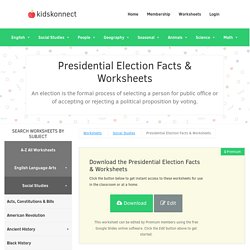
Click to download the free sample version Download sample Download This Sample This sample is exclusively for KidsKonnect members! To download this worksheet, click the button below to signup for free (it only takes a minute) and you'll be brought right back to this page to start the download! Sign Me Up. Sans titre. Presidential Elections: ESL Lesson.
It's the presidential election season in the United States and the topic is quite popular in classes around the country.
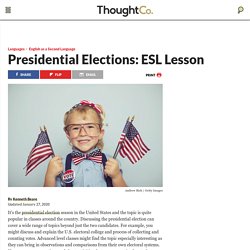
Discussing the presidential election can cover a wide range of topics beyond just the two candidates. For example, you might discuss and explain the U.S. electoral college and process of collecting and counting votes. Advanced level classes might find the topic especially interesting as they can bring in observations and comparisons from their own electoral systems. Electing a US President in Plain English.
Sans titre. Sans titre. The Election Collection. Sans titre. Sans titre. Sans titre. Sans titre. US elections 2020. The Presidential Suite - Official Music Video. The one scenario that could still get Hillary into the White House. For die-hard Democrats holding out hope that they won’t have to live through a Trump presidency, there is a last, incredibly long shot for them latch on to — a surprise twist in the Electoral College.
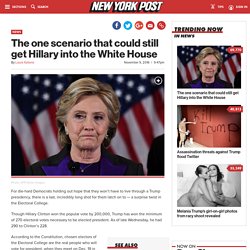
Though Hillary Clinton won the popular vote by 200,000, Trump has won the minimum of 270 electoral votes necessary to be elected president. As of late Wednesday, he had 290 to Clinton’s 228. According to the Constitution, chosen electors of the Electoral College are the real people who will vote for president, when they meet on Dec. 19 in their respective state capitals. However, there is technically nothing stopping any of the electors from voting their conscience and refusing to support the candidate to whom they were bound, or from abstaining from voting altogether.
There’s even a name for it: becoming a “faithless elector.” Well over 99 percent of electors throughout American history have voted as pledged, according to an analysis done by the New York Times. It does happen, though. Election 2016: From Trump Tower to the US presidential election. US election: Eight things that terrify US liberals. Watch a Brief History of Presidential Concession Speeches. U.S. Political Party Animals. Electionary.
Campaign: the competition for public office; organized actions that a candidate takes in an attempt to win an election.

US Presidential Election – WebEnglish.se. This theme page presents lesson plans and materials to learn about the US presidential election of 2020 in years 6-9 and above (A2-B1) of the Swedish Compulsory School. Related pages: U.S. Famous cartoonist made donkey and elephant the symbols of political parties. Thomas Nast’s cartoon shows a donkey in a lion’s skin scaring an elephant and other animals.
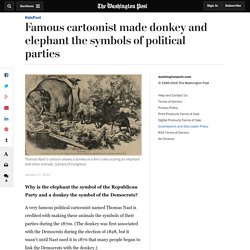
(Library of Congress) Why is the elephant the symbol of the Republican Party and a donkey the symbol of the Democrats? A very famous political cartoonist named Thomas Nast is credited with making these animals the symbols of their parties during the 1870s. (The donkey was first associated with the Democrats during the election of 1828, but it wasn’t until Nast used it in 1870 that many people began to link the Democrats with the donkey.)
In 1874, Nast drew the cartoon shown above with a donkey wearing a lion’s skin and scaring all the other animals in the forest. Bonus fun fact: Nast was the first person to draw Santa Claus as a fat, bearded elf. Fun facts about Clinton and Trump – Lesson Plan. Much of the media’s coverage of presidential candidates typically focuses on either the candidates’ policy stances or image.
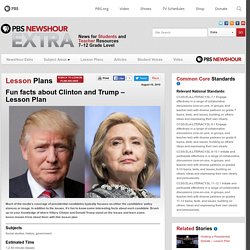
In addition to the issues, it’s fun to know some interesting facts about each candidate. Brush up on your knowledge of where Hillary Clinton and Donald Trump stand on the issues and learn some lesser-known trivia about them with this lesson plan. Subjects Social studies, history, government Estimated Time 1-2 50 minute classes Grade Level.
Gravity: Fun Facts about Hillary Clinton and Donald Trump. Scholastic News Election 2016. Scholastic News Election 2016. List of political parties in the United States. This is a list of political parties in the United States, both past and present.
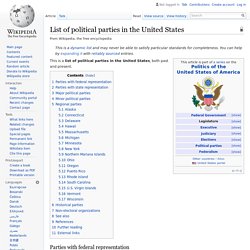
Parties with federal representation Current United States Congressional seats. 2016 Presidential Candidate Positions on 75 Issues - 2016 Presidential Election - ProCon.org. Flag timeline. Adoption of State Flag Desecration Statutes — By the late 1800's an organized flag protection movement was born in reaction to perceived commercial and political misuse of the flag.
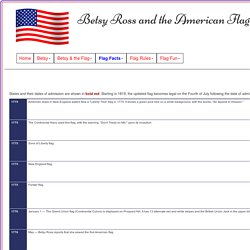
After supporters failed to obtain federal legislation, Illinois, Pennsylvania, and South Dakota became the first States to adopt flag desecration statutes. By 1932, all of the States had adopted flag desecration laws. In general, these State laws outlawed: (i) placing any kind of marking on the flag, whether for commercial, political, or other purposes; (ii) using the flag in any form of advertising; and (iii) publicly mutilating, trampling, defacing, defiling, defying or casting contempt, either by words or by act, upon the flag.
Why do Americans vote on Tuesdays? Words to know election day and questions to answer.
How do they work? Electing a US President in Plain English. Presidential Timeline. Topics in US History: Political Parties - The Edge. Hi!
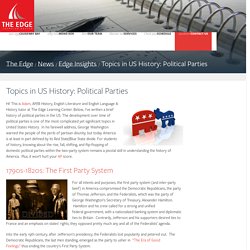
This is Adam, AP/IB History, English Literature and English Language & History tutor at The Edge Learning Center. Below, I’ve written a brief history of political parties in the US. The development over time of political parties is one of the most complicated yet significant topics in United States History. In his farewell address, George Washington warned the people of the perils of partisan disunity, but today America is at least in part defined by its Red State/Blue State divide. US election 2016: How does it all work? Image copyright Getty Images In January 2017, the most powerful nation on earth will have a new leader, after a drawn out and expensive campaign - but how does a US presidential election work?
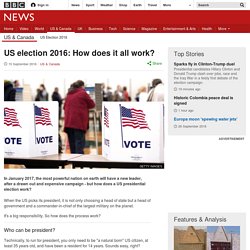
When the US picks its president, it is not only choosing a head of state but a head of government and a commander-in-chief of the largest military on the planet. It's a big responsibility. So how does the process work? Who can be president? Technically, to run for president, you only need to be "a natural born" US citizen, at least 35 years old, and have been a resident for 14 years. In reality, however, every president since 1933 has been a governor, senator, or five-star military general. In this 2016 election, at one stage there were 10 governors or former governors and 10 who are or were senators, although many have since dropped out. Great Presidential Speeches. Campaign Marathon. CREDIT: Danny Johnston/AP Images (Trump); Justin Sullivan/Getty Images (Clinton); J. Countess/Getty Images (Carson); Joe Raedle/Getty Images (Sanders); Win McNamee/Getty Images (Rubio) Fullscreen Close It already feels like the presidential election has been going on forever. And there’s still almost a year until we cross the finish line.
By Rebecca Zissou | November 23, 2015. Meet the Candidates. What’s at Stake. CLINTON favors raising the federal minimum wage to $12 an hour and providing more tax breaks for working families. She wants the wealthiest Americans to pay higher taxes. She also wants the government to spend more on infrastructure projects like roads and bridges to provide jobs and grow the economy. TRUMP says the U.S. needs to renegotiate its trade deals to make them more beneficial to American companies and workers. He’s also proposed a 45 percent tariff on goods coming into the U.S. from China. To encourage economic growth, he wants to lower the corporate tax rate and simplify the tax code for everyone. CLINTON supports broad immigration reform and, like President Obama, says she favors protections for certain groups of undocumented immigrants, including young people brought here illegally as children.
Why the Donkey and Elephant? The Donkey— Presidential candidate Andrew Jackson was the first Democrat ever to be associated with the donkey symbol. His opponents during the election of 1828 tried to label him a "jackass" for his populist beliefs and slogan, "Let the people rule. " Jackson was entertained by the notion and ended up using it to his advantage on his campaign posters. But cartoonist Thomas Nast is credited with making the donkey the recognized symbol of the Democratic Party. It first appeared in a cartoon in Harper's Weekly in 1870, and was supposed to represent an anti-Civil War faction. Rock the Vote: Register to Vote Today! Uncle Sam: 1814. Samuel Wilson was a businessman from Troy, NY, that supplied beef in barrels to the U.S.
Army during the War of 1812. The barrels were labeled "U.S. " When asked what the initials stood for, one of Wilson's workers said that it stood for Uncle Sam Wilson. White House: 1792. Political Parties Rap - Smart Songs. Clinton, Trump Are a Study in Contrasts. American businessman Donald Trump and former Secretary of State Hillary Clinton are likely to face each other in the U.S. presidential election this year. Both candidates call New York State their home. But that might be the only thing they have in common. Donald Trump came from a wealthy family. He is known for building hotels and casinos around the world. The businessman says that the U.S. political system is broken and it will take a non-politician like himself to fix it.
160516 HuffPost USelection Graphic F black nointro. 2016 Presidential Election. “Democracy cannot succeed unless those who express their choice are prepared to choose wisely. The real safeguard of democracy, therefore, is education.” – Franklin D. Election Printables. VOA Learning English - U.S. Elections 2016 VOA - Voice of America English News. Election Printables.